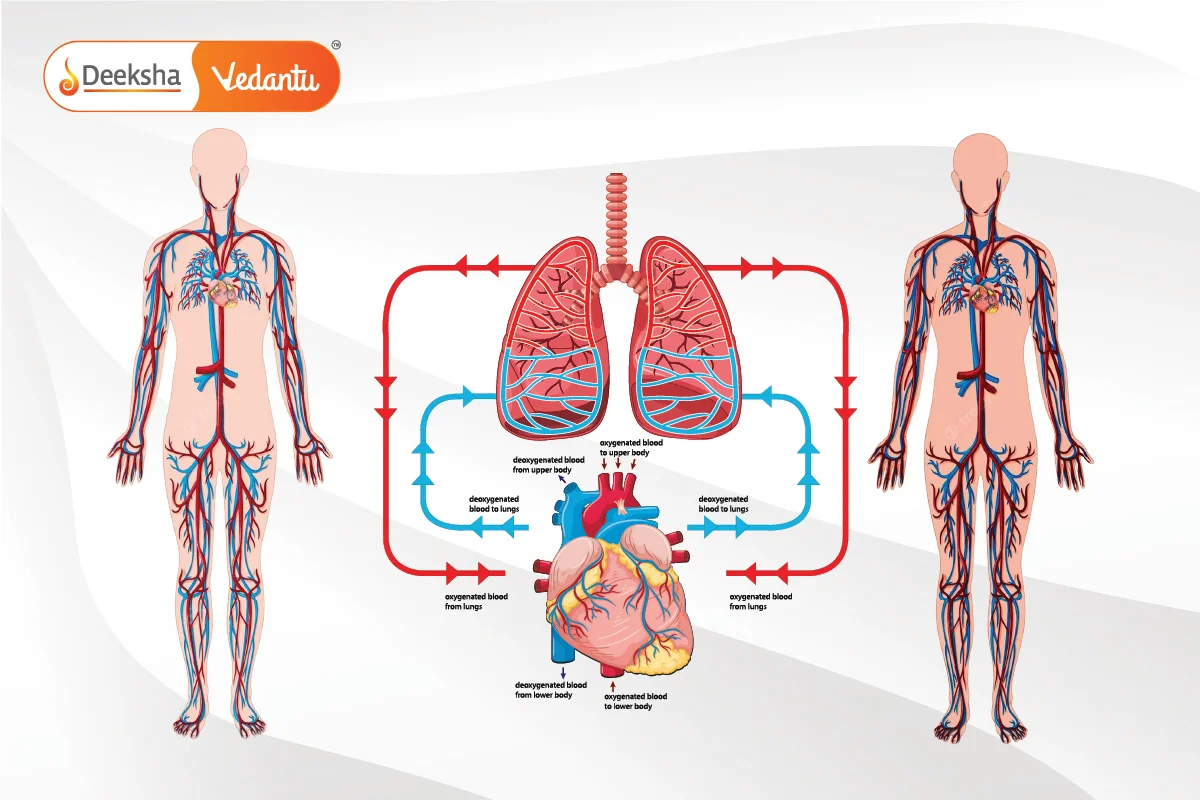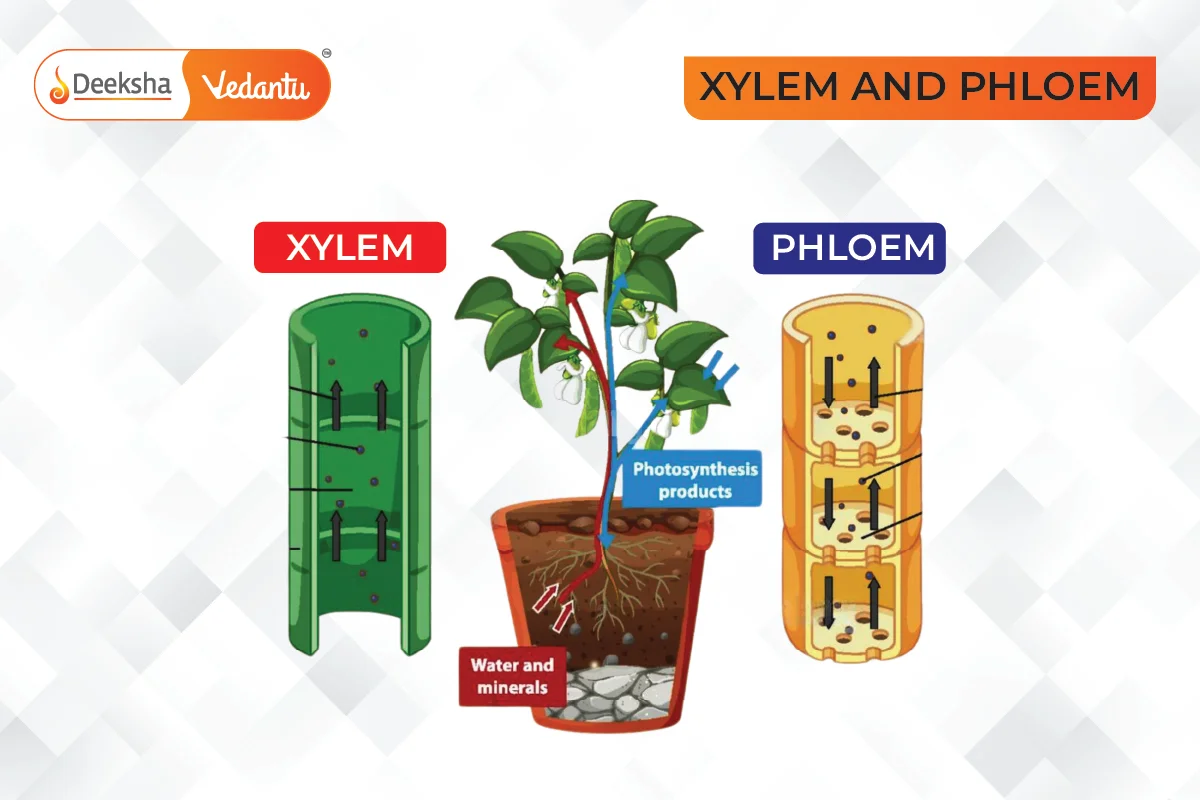Introduction
Transportation is the life process responsible for the movement of substances like nutrients, gases, and waste products throughout an organism. This process ensures that every cell in the organism receives the essential materials for survival, while waste products are eliminated. In multicellular organisms, specialized transportation systems are developed to carry out these tasks efficiently, such as the circulatory system in animals and vascular tissues in plants.
Transportation in Human Beings
In humans and other multicellular animals, a circulatory system is responsible for the transportation of nutrients, gases, and waste. This system consists of the heart, blood, and blood vessels (arteries, veins, and capillaries).
Circulatory System Components:

- Heart:
- The heart acts as a muscular pump that circulates blood throughout the body. It consists of four chambers—two atria and two ventricles—that ensure the separation and efficient circulation of oxygenated and deoxygenated blood.
- Blood enters the heart through the atria and leaves through the ventricles.
- Blood:
- Blood is a fluid connective tissue that transports oxygen, carbon dioxide, nutrients, hormones, and waste products.
- Red Blood Cells (RBCs) carry oxygen using the pigment hemoglobin.
- White Blood Cells (WBCs) help in fighting infections.
- Platelets help in blood clotting during injury.
- Plasma is the liquid portion that carries nutrients, waste products, and carbon dioxide.
- Blood Vessels:
- Arteries carry oxygenated blood away from the heart to various parts of the body.
- Veins return deoxygenated blood back to the heart.
- Capillaries are thin blood vessels where the exchange of gases (oxygen and carbon dioxide), nutrients, and waste products occurs.
Double Circulation:
Humans exhibit a double circulation system where blood passes through the heart twice in one complete cycle: once to the lungs for oxygenation (pulmonary circulation) and once to the body (systemic circulation).
- Pulmonary Circulation: Blood is pumped from the heart to the lungs, where it picks up oxygen and releases carbon dioxide.
- Systemic Circulation: Oxygenated blood is pumped from the heart to the rest of the body, delivering oxygen and nutrients to tissues, and returning deoxygenated blood to the heart.
Lymphatic System:
In addition to blood, humans have a lymphatic system that helps in transporting excess tissue fluid (lymph) back into the blood, as well as in absorbing fats from the intestines and fighting infections.
Real-Life Example:
When you exercise, your body requires more oxygen and nutrients to produce energy. Your heart pumps faster to increase blood flow, ensuring your muscles receive the necessary resources and waste products are removed quickly.
Transportation in Plants

Plants also need to transport water, nutrients, and food throughout their bodies. Since they do not move, plants have specialized tissues for this purpose: xylem and phloem.
Xylem:
- Xylem tissue is responsible for the upward transportation of water and minerals from the roots to the leaves.
- Water is absorbed by the roots from the soil and moves upward through the xylem due to root pressure and transpiration pull.
- Transpiration is the process by which water evaporates from the surface of leaves through small openings called stomata, creating a suction force that pulls water upward through the plant.
Phloem:
- Phloem tissue transports the products of photosynthesis, mainly sugars (glucose), from the leaves to other parts of the plant, such as roots, stems, and fruits. This process is known as translocation.
- Unlike xylem, the flow in phloem can move in both directions to deliver nutrients where they are needed.
Real-Life Example:
Tall trees rely on their xylem system to transport water from the roots to the leaves at great heights. This process is driven by transpiration, and without it, the leaves would dry out.
Real-Life Applications
- Heart Health: Understanding the circulatory system is crucial for preventing heart-related diseases such as hypertension and heart attacks. Monitoring blood pressure and heart rate can provide early warning signs of cardiovascular issues.
- Agriculture: Farmers ensure that crops receive enough water for transpiration to support plant growth. Irrigation systems are designed to maximize water uptake by the roots, which is then transported to other parts of the plant through the xylem.
Conclusion
Transportation is a critical life process in both animals and plants. In animals, the circulatory system ensures that every cell receives oxygen, nutrients, and waste products are efficiently removed. In plants, the vascular tissues (xylem and phloem) transport water, minerals, and food throughout the plant, ensuring its growth and survival. Understanding these systems helps us appreciate the complexity of life and how organisms maintain homeostasis.
Practice Questions
Q1: What are the components of the human circulatory system, and what are their functions?
- Answer: The components of the circulatory system include the heart (pumps blood), blood vessels (transport blood), and blood (carries oxygen, nutrients, and waste). The heart pumps blood through arteries, veins, and capillaries to deliver oxygen and nutrients to tissues and remove waste products.
Q2: Explain the role of xylem and phloem in plants.
- Answer: Xylem transports water and minerals from the roots to the leaves, while phloem transports sugars produced in the leaves during photosynthesis to other parts of the plant.
Q3: Why is the separation of oxygenated and deoxygenated blood necessary in birds and mammals?
- Answer: The separation of oxygenated and deoxygenated blood ensures that tissues receive a constant supply of oxygen-rich blood, which is essential for maintaining high metabolic rates in birds and mammals.
Q4: Why is double circulation necessary in humans?
- Answer: Double circulation ensures the separation of oxygenated and deoxygenated blood, which improves the efficiency of oxygen delivery to body tissues.
Q5: How does the heart pump blood?
- Answer: The heart has four chambers. Blood enters the heart through the atria and is pumped out through the ventricles. The right side of the heart sends deoxygenated blood to the lungs for oxygenation, while the left side pumps oxygenated blood to the rest of the body.
Q6: How do xylem and phloem differ in their functions?
- Answer: Xylem transports water and minerals from the roots to the leaves, while phloem transports food (sugars) from the leaves to other parts of the plant.
FAQs
Transpiration creates a suction force that pulls water upward from the roots to the leaves through the xylem. This process helps in the absorption and distribution of water and minerals throughout the plant.
The lymphatic system helps in draining excess fluid from tissues, absorbing fats from the intestines, and fighting infections through lymph nodes and lymphocytes.
Hemoglobin is a protein found in red blood cells that binds to oxygen in the lungs and transports it to the tissues. It also helps in transporting carbon dioxide from tissues back to the lungs for exhalation.







Get Social